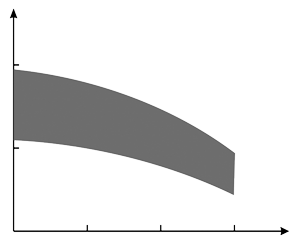Microwave absorbing composite materials
DOI:
https://doi.org/10.3103/S0735272723010065Keywords:
composite materials, metallic fillers, percolation, magnetic fillers, dielectrics with high dielectric permittivityAbstract
Designing of microwave systems based on composite materials involves the need of thorough understanding of interaction processes of electromagnetic waves with such materials and factors that affect this interaction. Polymer-based composites filled with materials having a high degree of electromagnetic energy absorption make it possible to combine electric properties of composite material with the mechanical elasticity, chemical resistance, and good fabrication properties. Selecting materials and their processing techniques, it is possible to achieve the required properties, both electrodynamic and mechanical. Composite properties are essentially influenced by such factors as the size and shape of filler particles, the volume fraction of filler, etc. Therefore, this paper considers different types of fillers for producing polymer-based composites, namely, magnetic materials, metals, carbon, and dielectrics with high dielectric permittivity. Advantages and disadvantages of the above fillers are analyzed. It has been shown that in the millimeter wavelength range, the relevent composites are those, in which the absorption is implemented due to the inclusion of polar dielectrics into their composition.
References
- F. Meng et al., “Graphene-based microwave absorbing composites: A review and prospective,” Compos. Part B Eng., vol. 137, pp. 260–277, 2018, doi: https://doi.org/10.1016/j.compositesb.2017.11.023.
- G. M. Kunkel, Shielding of Electromagnetic Waves. Cham: Springer International Publishing, 2020, doi: https://doi.org/10.1007/978-3-030-19238-9.
- M. D. Stelescu, D. Comeaga, M. Sonmez, D. Gurau, “The mechanical properties of some polymer composites based on natural rubber,” Mater. Plast., vol. 55, no. 1, pp. 15–120, 2018, uri: https://sdbindex.com/Documents/index/00000543/00001-62661.
- Y. Poplavko, Electronic Materials: Principles and Applied Science. Amsterdam: Elsevier, 2018, uri: https://www.elsevier.com/books/electronic-materials/poplavko/978-0-12-815255-3.
- T.-D. Ngo, Ed., Composite and Nanocomposite Materials - From Knowledge to Industrial Applications. IntechOpen, 2020, doi: https://doi.org/10.5772/intechopen.80186.
- V. Bovtun et al., “Microwave absorbing and shielding properties of inhomogeneous conductors and high-loss dielectrics,” Ferroelectrics, vol. 532, no. 1, pp. 57–66, 2018, doi: https://doi.org/10.1080/00150193.2018.1499404.
- V. Bovtun et al., “Composition dependent microwave properties of dielectric-conductor nanocomposites,” Phase Transitions, vol. 91, no. 9–10, pp. 1027–1035, 2018, doi: https://doi.org/10.1080/01411594.2018.1508681.
- J. Petzelt, D. Nuzhnyy, V. Bovtun, M. Savinov, M. Kempa, I. Rychetsky, “Broadband dielectric and conductivity spectroscopy of inhomogeneous and composite conductors,” Phys. Status Solidi, vol. 210, no. 11, pp. 2259–2271, 2013, doi: https://doi.org/10.1002/pssa.201329288.
- M. T. Sebastian, R. Ubic, H. Jantunen, Eds., Microwave Materials and Applications. Wiley, 2017, uri: https://www.wiley.com/en-sg/Microwave+Materials+and+Applications%2C+2+Volume+Set-p-9781119208525.
- Y. M. Poplavko, D. D. Tatarchuk, Y. V. Didenko, D. V. Chypegin, “Blurred relaxation spectra in dielectric materials,” Radioelectron. Commun. Syst., vol. 65, no. 5, pp. 221–234, 2022, doi: https://doi.org/10.3103/S0735272722050016.


